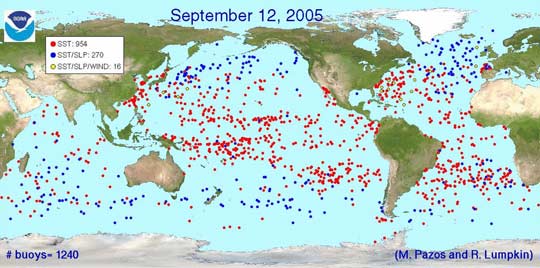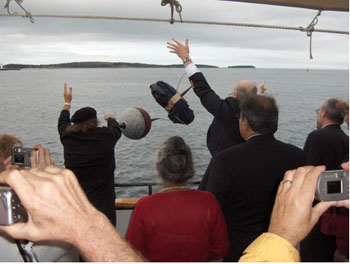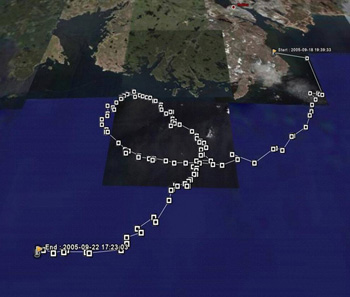 |
|||||||||
skip to content |
|||||||||
Deployment of Global Drifter 1250: Completion of the first component of the Global Ocean Observing System
Mike Johnson, Director of the NOAA Office of Climate Observation, and Peter Niiler, Director of the Joint Institute for Marine Observations at Scripps Institution of Oceanography, deployed Global Drifter 1250 in waters off Halifax on September 18, 2005. |
Global Drifter 1250 was launched near Halifax, Nova Scotia this past fall, marking the full implementation of the first component of the Global Ocean Observing System (GOOS). This historic drifter launch also completes the first element of the Global Earth Observation System of Systems (GEOSS). NOAA's Director of the NOAA Office of Climate Observation, Mike Johnson, and the Director of the Joint Institute for Marine Observations at Scripps Institution of Oceanography, Peter Niler, launched Global Drifter 1250 from the Tall Ship Silva in September, 2005.
The Global Ocean Observing System combines measurements from drifting and moored data buoys, profiling floats, tide gauge stations, ship-based systems, and satellites to monitor and document the state of the ocean. The observing system has been designed primarily to meet climate requirements, but the system also supports global weather prediction, global and coastal ocean prediction, marine hazard warning, marine environment and ecosystem monitoring, navigation, naval applications, and many other non-climate uses.
The global drifting buoy array is one component of the ocean observation system of systems that is being implemented worldwide by the JCOMM Members/Member States. The United States, and in particular NOAA*, is the principal contributor.

National Oceanic and Atmospheric Administration's (NOAA) Global Ocean Observing System and Global Climate Observing System |
Drifting buoys measure ocean temperature, currents, and atmospheric pressure over the ocean. They also provide the primary calibration system, or “ground truth,” for satellite measurement of sea surface temperature, which is essential for climate, weather, and storm prediction. The scientific design for the global surface drifting buoy array calls for 1250 buoys to be maintained worldwide based on the requirement for buoy measurement of sea surface temperature in combination with satellite measurements. One buoy is needed approximately every 500 kilometers, over the entire global ocean, to calibrate the satellites. If the global ocean is conceptually divided into 500x500 kilometer square boxes, it takes 1250 boxes to cover the ocean. One buoy per box equals 1250 buoys.
The countries participating in the Data Buoy Cooperation Panel of JCOMM have been working for 10 years to collectively build the resources necessary to maintain 1250 buoys in sustained service. The deployment of Global Drifter 1250 symbolizes filling of the final 500x500 kilometer box.
Global Drifter 1250's path four days after launch. |
Related News and Media
JCOMM Announcement - Celebration of the Deployment of Global Drifter 1250 - JCOMM Website
Global Drifter 1250 - Marine and Environmental Data Services, Fisheries and Oceans Canada
Milestone Achieved in Oceans Observation - CNW Group, 09/18/05
Ocean Instrument Program Led by Scripps Set to Achieve World Coverage - Scripps Institution of Oceanography, 09/12/05
Ocean Instrument Program Led by Scripps Set to Achieve World Coverage - University of California, San Diego, 09/12/05
Ocean Instrument Program Led by Scripps Set to Achieve World Coverage - Innovations Report, 09/12/05
*NOAA supplies 1064 of the 1250 drifting buoys, and 54% of the global ocean observing system. The drifter project in NOAA is managed jointly by the Atlantic Oceanographic and Meteorological Laboratory and the Scripps Institution of Oceanography.
|
NOAA's Climate Program Office plans, programs, resources, and implements a suite of climate programs and services intended to enhance the Nation's understanding of and ability to respond to the effects of climate variability and change. The Office provides design principles and a management framework for the research, modeling, observations, and information products, as well as partnerships, demonstrations, and evaluations necessary to provide regional and national climate services. The Office achieves its mandate through management of a network of activities that maintain well-structured paths from observations, modeling, research and operations to usable information. These paths are established in the context of eliciting and analyzing climate science and services requirements, spanning the information needs of science and society. They include: sponsoring competitively selected research and development activities; developing, with international partners, global climate observing systems; transitioning successful sustained products to operational realities; developing and evaluating a suite of both research and operational climate products and services; and providing educational, outreach and training activities to enhance the reach and relevance of climate services. |
1/9/2006
CLIMATE · OCEANS, GREAT LAKES, and COASTS · WEATHER
and AIR QUALITY
ABOUT US · RESEARCH
PROGRAMS · EDUCATION · HOME

